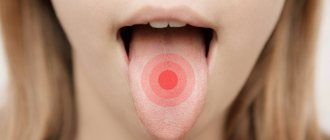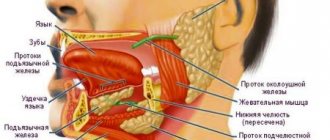The bridle is a film. The tongue is attached by this film to the lower jaw, to the oral cavity. The normal length of the frenulum is 1.5 centimeters. If it is smaller than usual, then the movements of the tongue are limited. It happens that it is shorter than usual or is in the wrong place. All this interferes with speaking correctly. And people with such problems wonder how to fix it so as not to cause themselves pain. If infants have such a pathology, then this prevents them from latching onto the breast correctly. But how to lengthen your tongue? The methods below will help you make your tongue longer.
How to stretch the frenulum for children?
For infants, this procedure can be done in the maternity hospital: the surgeon cuts the baby’s frenulum without anesthesia and immediately after the operation they give the mother’s breast. Children aged 4-5 years undergo surgery and stitches, after which classes are held with a speech therapist. In order not to harm the child with exercises, you need to warn the speech therapist about the operation. Sometimes people learn about this problem already in adulthood. An adult can stretch the frenulum in the same way as a child. You need to devote a lot of time to studying. If a person decides to do such an act, then he needs to take it seriously. Exercises are performed 3 times a day, for 10-12 minutes.
The cause of this phenomenon has not yet been determined, but it could be heredity, pregnancy at a late age, or problems with intrauterine development.
Giraffe
The giraffe (lat. Giraffa camelopardalis) is the tallest of all mammals living on Earth. It is not surprising, but the giraffe sometimes lacks its height, so it quite often resorts to the help of its long tongue (45 cm). In addition to the fact that the giraffe's tongue is long, it is also very agile.
flickr/Timfy Mills
With its help, the animal easily removes foliage from trees and bushes. It is interesting that the lips and tongue of a giraffe are designed in such a way that they are not damaged at all, either by thorns or tree branches.
Lengthening methods
There are two ways to lengthen the tongue: the first way is surgery, that is, surgery; the second way is to lengthen the tongue at home with the help of exercises. True, the second method requires a long time and a lot of effort. To lengthen the tongue, they use a set of exercises that must be performed every day, otherwise there will be no result.
How to correct malocclusion and tongue position.
There must be an integrated approach. Modern orthodontics offers various ways to straighten teeth. But as we have already seen, straightening teeth is ineffective without eliminating the causes leading to these changes.
Therefore, the solution to the problem of malocclusion should be aimed at the entire complex of pathological changes: restoration of the anatomically correct position of the tongue, development of the correct stereotype of swallowing, chewing, head position, posture.
Osteopathic treatment offers exactly this approach: restoration or formation of the correct relationship of anatomical structures
- Correction of weakened or excessively tense muscles of the face, neck, floor of the mouth and the tongue itself, this will lead to the restoration of the correct position of the tongue in the oral cavity and uniform participation of the corresponding muscle chains in the processes of chewing and swallowing.
- The effect on the bone structures that form the cavities of the nose and mouth leads to the restoration of the physiological volumes of these cavities and helps improve nasal breathing, chewing, swallowing and speech.
- Motor innervation of the tongue, swallowing and chewing is provided by the hypoglossal nerve, which exits the cranial cavity through the canal of the hypoglossal nerve, where in some cases it may be compressed. Until a certain age, mobility is maintained in this zone and using osteopathic methods it is possible to restore the physiological correspondence of these anatomical structures.
Exercises
The lengthening of the tongue depends on the condition of the hyoid frenulum.
If it is not developed and is short, then the following exercises should be used:
- “Mushroom” - you need to open your mouth wide and smile. Then suck your tongue to the roof of your mouth so that the tip does not curl up. And you still need to smile. Exercises should be done for one minute, then increase the time every day. This way, the ligament will gradually stretch and will not be damaged.
- “Painter” - you need to open your mouth and smile. Run the tip of your tongue across the roof of your mouth from your teeth to your throat and back. And this needs to be done several times without moving the lower part of the jaw.
- Smiling, open your mouth. You need to stretch your tongue to your nose, then to your upper lip. The tongue should not be constricted; it should be in a relaxed state. It won't work out right away, but over time everything will work out. During this exercise, you need to make sure that your lips and lower jaw do not move.
- Smiling, place your tongue as in the “Mushroom” exercise and open and close your mouth. There may be some pain in the ligament area, but this is normal as this exercise helps stretch the hyoid ligaments.
- “Horse” - you need to put your tongue in the “Mushroom” position and click your tongue, as if imitating the clopping of a horse. You have to suck your tongue and click, suck and click. In this exercise, only the tongue works, the lower jaw is motionless.
- "Kitty". This exercise is reminiscent of how a cat laps milk. So a person needs to try this, sticking his tongue out.
All these exercises will bring results only when a person does them every day and several times.
If you don’t want to perform this complex, then you can simply stretch your tongue to your nose. This exercise should be done frequently over a long period of time. It’s not for nothing that they say: “If you suffer for a long time, something will work out.” Therefore, you need to put in as much effort as possible.
This is the main way to lengthen your tongue at home; exercises can be done at any age. Kids will be able to cope with them from the age of two years.
Diseases that cause dry mouth
In some pathologies, severe dry mouth can be a symptom, in others it accompanies the course of the disease.
Inflammatory diseases of the oral cavity
With inflammation of the gums or dental diseases, the amount of saliva may decrease due to greater fluid consumption for chewing food. The same situation occurs with a bad prosthesis. The salivary glands simply do not have time to replenish their reserves.
Diabetes
Excess weight is accompanied by metabolic disorders. If you are always thirsty and your throat is “dry”, and trips to the refrigerator are becoming more and more frequent, you should check your blood sugar level and make an appointment with an endocrinologist.
“Dry mouth and thirst are the first signs of diabetes.”
Especially if the above symptoms are accompanied by repeated visits to the toilet at night.
Infections
Infectious diseases are often accompanied by vomiting and diarrhea accompanied by fever. Losing a large amount of fluid causes dry mouth, which, usually, in this condition, few people pay attention to. However, this cannot be ignored. With severe intoxication, fluid loss is an additional risk factor, so the patient needs to drink a lot. Water removes toxins from the body and replenishes fluid deficiency.
Endocrine diseases
Some endocrine diseases may be accompanied by a decrease in the amount of saliva produced, for example, thyroid dysfunction. In women, dry mouth may be associated with pregnancy or menopause.
Xerostomia in autoimmune diseases
With autoimmune diseases, a person’s defenses fail and they attack their own body. This damages the entire system. The second name for these diseases is systemic.
As a striking example, consider Sjögren's syndrome. The disease affects the salivary glands, causing dry mouth and difficulty swallowing. The oral mucosa becomes bright pink.
Xerostomia in diseases of the brain and nervous system
During a stroke, partial death of brain cells occurs; it is difficult to predict which functions will be affected. Dryness of the oral mucosa can also occur with Alzheimer's or Parkinson's disease, pathologies of the trigeminal nerve and circulatory system.
Gastrointestinal tract and dry mouth: what diseases require an appointment with a gastroenterologist
Particularly noteworthy are diseases of the gastrointestinal tract. Xerostomia is not one of the symptoms of these diseases, but may accompany them:
- A stomach ulcer, as a result of smoking or drinking alcohol, is necessarily accompanied by dry mouth.
- Gastritis, acquired through dietary abuse or as a result of stress, also does not exist without this symptom.
- Acute pancreatitis is accompanied by vomiting and diarrhea, resulting in dehydration and its symptom – xerostomia.
Gastrointestinal diseases should not be joked about, so you need to visit a gastroenterologist and start treatment.
Acute pathologies requiring hospitalization
Acute pathologies, in addition to severe pain, also cause dry mouth. Appendicitis and intestinal obstruction, as well as perforation of the ulcer, require urgent surgical intervention.
Massage
You can do a simple massage to lengthen the tongue: grab the frenulum at the very bottom under the tongue with two fingers (index and thumb) and pull your fingers along it to the tip of the tongue. You must try to pull it, but you cannot use much force so as not to damage the thin fabric. In each session you need to do several of these techniques. Your fingers will quickly begin to feel the frenulum, and this action will not cause discomfort. By doing a massage 4-6 times a week, a person will be convinced that the frenulum has changed in length.
If the frenulum is less than 8 mm, then it is better to stretch it rather than operate. After surgery, a scar remains on the frenulum, which will reduce its mobility. In addition, a child who has undergone surgery will be afraid to do exercises so as not to experience the pain that he experienced during the operation.
Therefore, the best way to lengthen the tongue is to lengthen it with special exercises.
Bat
flickr/Jorge Brito M.
Scientists have been able to establish that the owner of the longest tongue among mammals is the bat (lat. Anoura fistulata). The length of her tongue is 8.5 cm, which is 3.5 times the length of her own body. This long tongue is necessary for the mouse to extract nectar from the Centropogon nigricans flower. And what’s interesting is that only these bats have adapted to extract nectar from this plant.
Komodo dragon or Komodo dragon
The Komodo dragon or Komodo dragon (lat. Varanus komodoensis) is the largest lizard in the world. It is also called the "land crocodile". The lizard itself grows up to 3 meters in length, and its tongue – up to 70 cm. Komodo dragons weigh about 70 kg.
flickr/myopixia
This is a large and powerful animal that can kill even a buffalo. To do this, they should only inflict a wound on their victim, and then just chase her and wait until she falls dead. The fact is that the monitor lizard’s saliva contains many bacteria, which, when they get into the victim’s wound, cause blood poisoning.
Preparing for surgery
Before the procedure, it is necessary to perform a number of preparatory measures:
- Consult a specialist.
- Perform diagnostic tests.
- At least 2 weeks before surgery, donate urine and blood for analysis, undergo testing for blood clotting, viral hepatitis, and HIV.
- Adult patients should undergo fluorography and, if necessary, an electrocardiogram.
- Take a test for an allergic reaction to the drugs used.
- Immediately before the operation, it is better to eat a hearty meal, since after the procedure this will not be possible for several hours.
- Perform professional oral hygiene and treat it with an antiseptic.
Methods of plastic surgery of the frenulum of the tongue
- Frenotomy (transverse intersection). This is the easiest way to correct the frenulum, with which you can correct the small thickness or width of the organ.
- Frenectomy (removal of a fragment of the frenulum). The method is used when the thickness and width of the hyoid fold is too large.
- Frenuloplasty (cutting and relocation). The technique helps to get rid of the pathology of fusion of the frenulum with the floor of the mouth or lower lip.
Frenotomy and frenectomy are fairly simple techniques that can be performed with a scalpel or laser. Frenuloplasty requires certain skills from the surgeon. The more preferable method of performing tongue frenuloplasty is the laser technique. Using a laser has a number of advantages:
- Speed of the procedure.
- No need for stitches.
- No bleeding during surgery.
- Instant disinfection of the cut surface.
- No scars after plastic surgery.
- Fast and comfortable recovery period.
Laser correction is often used in children, since surgical instruments that frighten the child are not used during the procedure. In addition, wound healing occurs much faster than after using a scalpel.
The frenuloplasty lasts no more than 30 minutes. Children need to remain calm for at least 15 minutes.
Recovery period
After plastic surgery of the frenulum of the tongue, in most cases, experts give the following recommendations for effective recovery:
- Do not eat or drink for several hours after the intervention. Drinking water is allowed.
- Visit your doctor as scheduled.
- Avoid eating hard and spicy foods while the wound is healing.
- Perform oral hygiene thoroughly and regularly. After each meal, rinse with an antiseptic solution.
- Do the exercises that the doctor tells you about.
Is it painful to perform lingual frenuloplasty?
Many parents worry about anesthesia, since tongue frenulum correction is mostly performed on children. Experts reassure: there will be no pain, since high-quality local anesthesia is used during plastic surgery. If the operation is performed with a laser, then you can do without anesthetics altogether. This technique is used in newborns. If pain relief is necessary, topical anesthetics in the form of gels, sprays, and ointments can be used.
Chameleons
Chameleons (lat. Chamaeleonidae) are the most unusual lizards from the order Scaly. One of the most basic features of a chameleon is its tongue, the length of which can reach about 50 cm. Usually the length of this organ corresponds to the length of its owner, therefore, the larger the lizard itself, the longer its tongue.
flickr/scott cromwell
But it’s possible to see the chameleon’s tongue in all its glory only after accelerated shooting. The entire hunting process (throwing out the tongue and returning it to its original position) lasts about 1/20 of a second. It is interesting that a chameleon is able to recognize and then catch up to 4 insects in 3 seconds.











